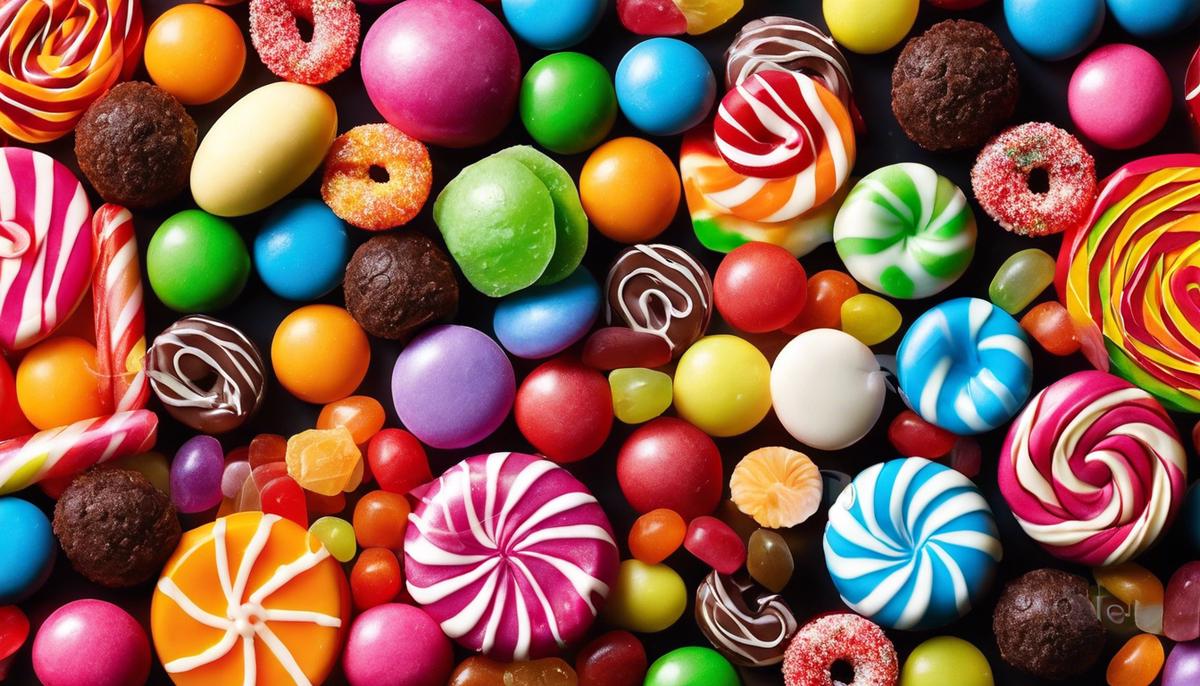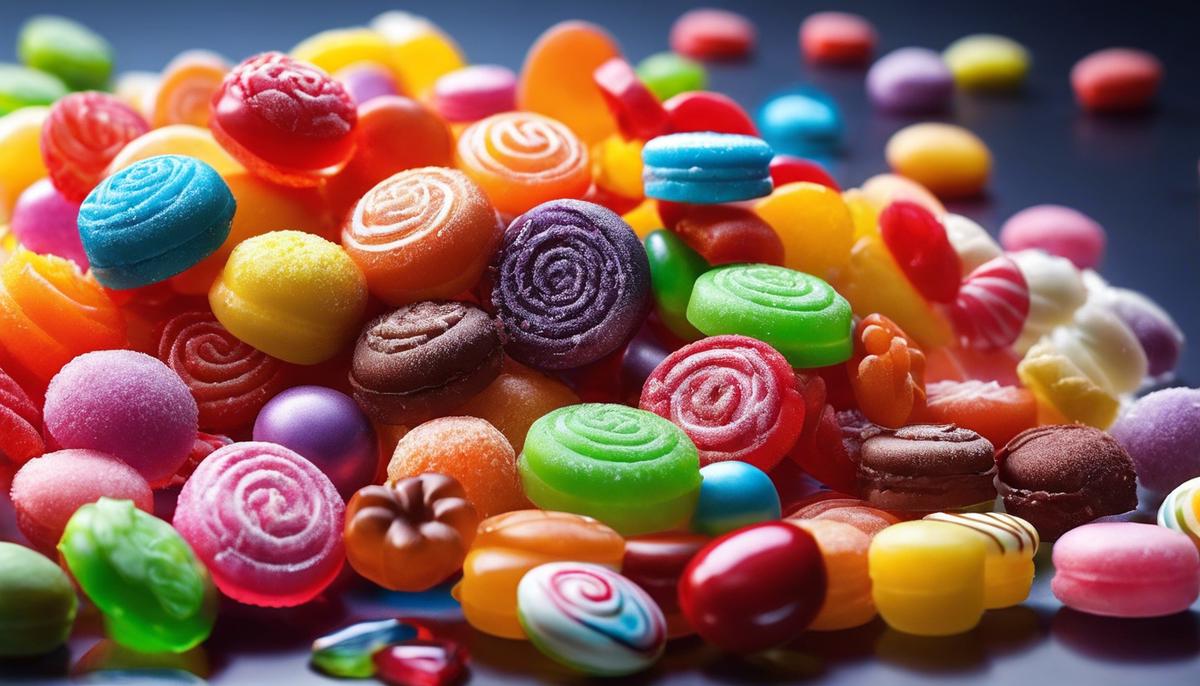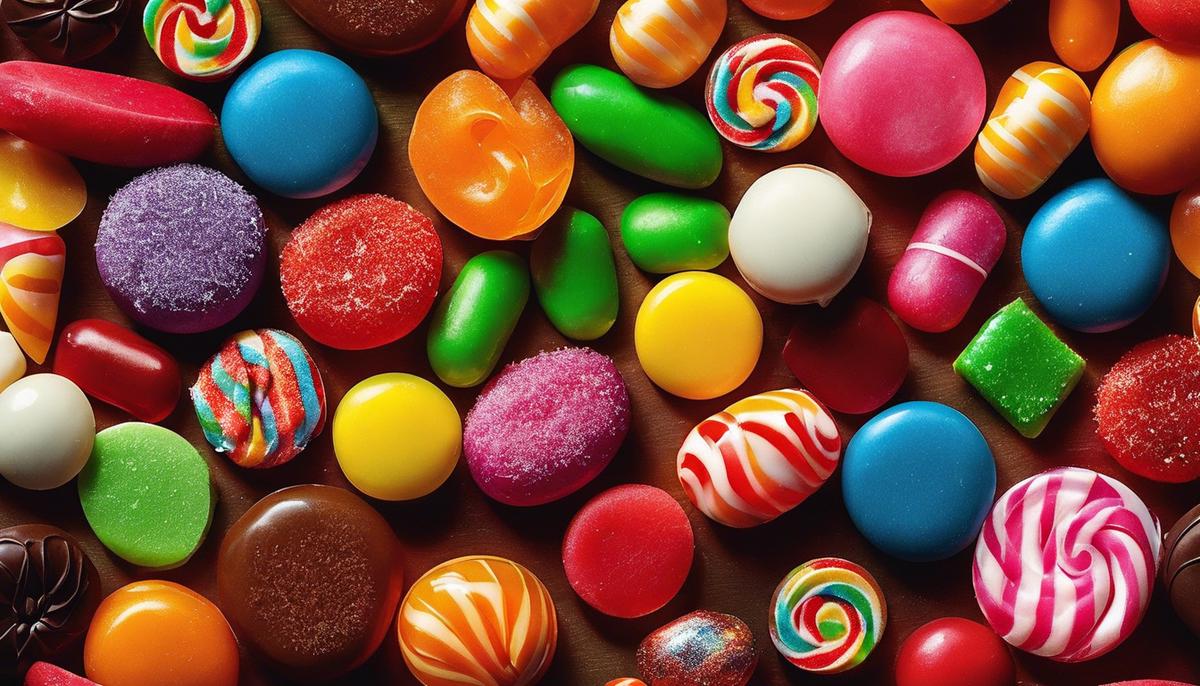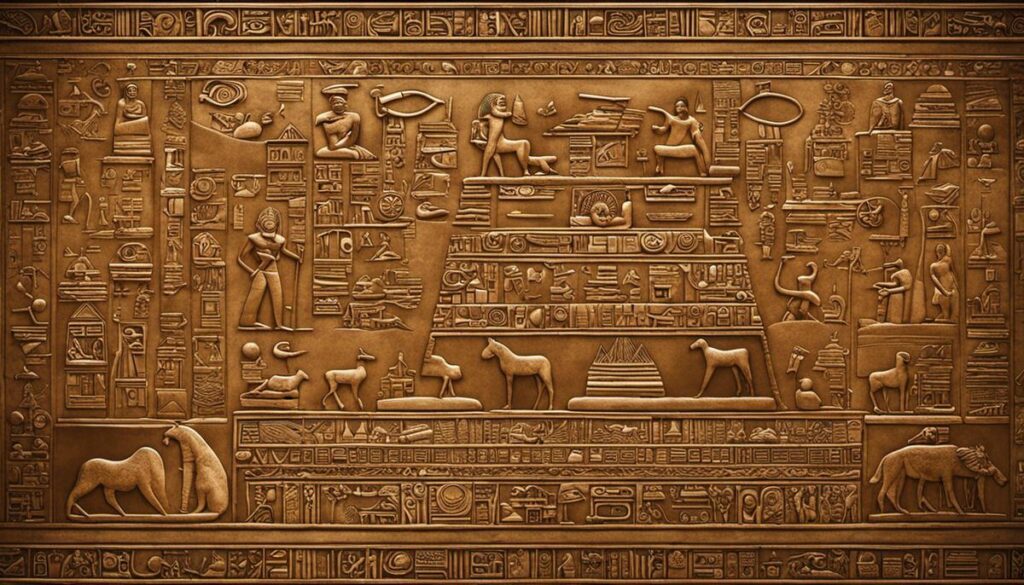Dreams have often been a subject of intrigue and speculation, with numerous theories spun around their meanings and implications. In particular, dreams about specific objects like candy invoke varying interpretations grounded in psychoanalytical, cultural, and scientific perspectives. Delivering an in-depth exploration of this fascinating subject matter, we delve into the labyrinth of candy dreams, as viewed from different lenses – psychoanalytical constructs associated with childhood pleasures and latent desires, cultural norms, and societal values, as well as insights from the scientific community. Additionally, we gauge how these interpretations might have practical repercussions, influencing our behavior and day-to-day decisions.
Psychoanalytical Perspectives on Dreaming of Candy
“Candy in Dream Interpretation: A Psychoanalytical Viewpoint”
Diving into the deep ocean of human consciousness, a realm of mystery and allure, one encounters the intriguing field of dream interpretation. Dreams have been a subject of human curiosity and scholarly research for centuries, and psychoanalysis has long proposed fascinating theories related to dream content and its potential meanings. One engaging subject in this sphere is the symbolism of candy in dreams, a remarkable reflection of human psyche per psychoanalytical understanding.
At its most elemental, candy – often associated with gaiety, pleasure, and sweet nostalgia – may appear in dreams as a symbol of joy and reward. Relatedly, it embodies the element of happiness, and offers insights into a dreamer’s subconscious desire for pleasure and indulgence.
However, dream symbols are not always as straightforward as they might seem. Candy, which is predominantly constituted of sugar, can represent overindulgence or excessive consumption in real life. From a psychoanalytical perspective, this association may hint at unfulfilled desires or guilt stemming from self-indulgence or hedonism.
Additionally, candies often have hidden centers or layers beneath their shiny, appealing exteriors. Analogously, when candies symbolically appear in dreams, they could be masking issues from the dreamer’s waking world. Conceivably, this could be something delightful that the dreamer is not allowing themselves to consciously acknowledge, or it could indicate a more daunting revelation patiently waiting to be uncovered.
In relation to color theory, the color of the candy can carry significant connotations. Red candies may symbolize passion or anger, green – growth or jealousy, while yellow may relay optimism or fear. Thus, color adds another layer to the interpretation, further facilitating exploration of the subconscious landscape.
Another potential meaning of candy in dreams could be associated with childhood. Given that candies are often fondly remembered from younger years, they might indicate a longing for simpler times or an ingrained need to resolve unresolved childhood issues.
Engaging in an intellectual pursuit such as dream interpretation demands piercing through the veil of obscurity and unveiling the arcane symbolisms inherent within. Unequivocally, interpreting the symbol of candy in dreams is more complex than it initially appears, opening up an array of psychoanalytical considerations.
In closing, the dynamic field of psychoanalytical dream interpretation implores us to look beyond the surface. The seemingly innocuous image of a candy in a dream may well be a symbolic narrative, a key that unlocks a hitherto unexplored door of our subconscious, thus proving – yet again – the inexhaustible depth and vastness of the human mind.

Cultural and Societal Interpretations of Candy Dreams
Evolving from the understanding that candies often denote joy or unfulfilled desires, it is now essential we delve into the interpretation of candy dreams within the frameworks of distinct cultures and societies.
When examining the Cultural Dreamscape Theory, we find that variables such as societal norms, local practices, and cultural traditions can significantly influence dream content. As such, candies in dreams can take on various meanings contingent on cultural and societal contexts.
In Chinese culture, for instance, symbolic associations of sweetness and prosperity may see dreams of candy as indicative of impending good fortune. These positive interpretations parallel Russian traditions that also propose a dream of candy as a harbinger of an auspicious event or auspicious news.
Contrastingly, the lore of Native American cultures links the sweetness of candy to the sweetness of life itself. Thus, in this cultural context, a dream of candy can be a symbolic prompt to savour each moment of life.
Meanwhile, in Japanese dream interpretation, the act of eating or giving candy implies a blossoming friendship or the improvement of interpersonal relationships.
In African cultures, particularly in certain West African societies, dreams about candies might signify that a spiritual feast or an ancestral offering may be required.
European traditions also warrant a highlight, for they exhibit a diverse set of interpretations. In Scandinavian cultures, dreaming of candy may symbolize a need for comfort or connection, whereas in French cultural dream theory, candies might represent a yearning for love and affection.
However, it’s noteworthy that these interpretations are not definitive. The intersection of individual and cultural backgrounds adds comprehensive dimensions, impacting dream interpretations. This variation in interpretation indicates the comprehensive and intricate nature of dream analysis.
In sum, it becomes abundantly clear that despite the common image of candies, these colorful delights can weave an array of meanings that span from the personal to the collective. Across different cultures, societies, and traditions, candies in dreams are imbued with a plethora of interpretations, acknowledging the substantial complexity of our dream worlds.
In profound ways, this exploration echoes the essence of human experience – similar in form, yet diverse in meaning – just like the colorful candies appearing in dreams. Thus, it’s prudent to appreciate that each interpretation could be a lens through which we glimpse not just individual psychology, but also the vast and fascinating tapestry of human culture.

Scientific Understanding of Dreaming about Candy
Dreams are deeply personal, intricate events, intricately woven tapestries of images, emotions, and sensations. Interpreting them is akin to piecing together a cosmic jigsaw puzzle, one where the pieces continuously evolve. Thus, when candies, effervescent harbingers of sweetness and delight, feature within a dreamscape, their interpretation diversifies to an even greater extent.
In the vast, varied terrain of the dream world, candies don a plethora of socio-cultural robes. Independent of any personal symbolic associations the dreamer may have with candies, numerous cultures around the globe ascribe specific esoteric meanings to candy dreams. Arguably, by taking cultural contexts into consideration, the endeavor of dream interpretation resonates at a more profound, enriching level.
For instance, in Chinese culture, dreams featuring candies herald good fortune. This interpretation positions candy dreams within a larger socio-religious framework linked to the Chinese concept of Feng Shui, where sweetness analogously denotes auspiciousness. Equally noteworthy is the Russian tradition that perceives candy dreams as signs of impending favorable news or events, a cultural interpretation that piquely marries dream symbolism to quotidian, real-world happenings.
In contrast, Native American cultures interpret candy dreams as subtle metaphysical reminders to appreciate and savor the multifaceted flavors of life. Japanese dream interpretation follows a similar route, viewing candy dreams as indicative of potential improvements in interpersonal relationships or the blossoming of new friendships.
West African societies offer an intriguing perspective on this theme, interpreting candy dreams as signaling a requisite for spiritual feasts or ancestral offerings. Incorporating a strong vein of spirituality, this interpretation underscores the evolving relationship between the dreamer and their ancestral roots.
European traditions too, place heavy emphasis on the symbolism of candy dreams. For instance, a Scandanavian might interpret candy dreams as a subconscious yearning for emotional warmth, connection, or comfort. The French, on the other hand, tend to interpret such dreams as a latent longing for love and affection.
The manifold interpretations that evolve from various societal and cultural factors highlight the immense diversity and complexity of dream analysis. They provide intriguing insights into the universality of shared symbolism, as well as the unique, individualistic experiences that thread into the rich tapestry of human life.
Amid these varying interpretations, it becomes evident that the pursuit of dream interpretation is no less than a journey, shedding light on an individual’s psyche as deeply as it does on the diverse culture that shapes it. In this journey, candies in dreams act as intriguing symbols, offering novel perspectives about the dreamer’s psyche while simultaneously illustrating the profound impact of societal and cultural realities on dream content.
In conclusion, the interpretation of sweets in dreams involves traversing through the lanes of individual memories, cultural symbolism and societal influence. It truly is a testament to the multidimensional and fascinating world of dream analysis, revealing the vast complexity of human experience and culture.

Practical Implications of Candy Dreams
Resuming the journey of dissecting the intricate symbolism of candies in dreams, the correlation between dream content and waking-life experiences or emotions isn’t merely coincidental. Recent studies in dream psychology assert a distinct link, suggesting that the interpretation of dream symbols, like candies, is an intricate process ingrained in personal experiences, emotions, and cultural contexts. Recognizing this, practical implications of candy appearing in dreams emerge, adding another layer to the understanding of a dreamer’s psyche.
In clinical psychotherapy, dream analysis can be utilized as a tool to identify underlying patterns of the subconscious mind. Candies in dreams could potentially function as ‘transitional symbols,’ linking real-life psychological states or experiences to the abstract realm of dreams. This could hold immense value in therapeutic settings, as deciphering these symbols could expose hidden emotional states or unresolved issues, thereby guiding therapeutic intervention strategies.
Exploring the field of neuroscience, a fascinating connection between dream content and neural patterns comes into play. In the case of dream candies, the associated emotions—joy, guilt, longing—might find resonance in specific brain wave patterns. This notion opens up an exciting sphere of inquiry: could monitoring these patterns during dream states provide insights into the emotional health and well-being of an individual? And could this lead to more targeted, effective mental health interventions?
In educational contexts, dream symbolism can offer an engaging way to introduce psychology concepts to students. The tangible symbol of candy may simplify the understanding of abstract ideas like the subconscious mind, emotion processing, or even cultural symbolism. Moreover, students could be encouraged to document and discuss their dreams, a practice supporting introspection and emotional intelligence.
Considering job sectors like market research or advertising, understanding dream symbols like candy can provide valuable insight. For instance, comprehending what candy symbolizes in dreams across different demographics could aid in formulating marketing strategies or crafting impactful ad narratives.
In criminal psychology, dream analysis continues to be a respected investigative tool. Recognizing what candy might symbolize to a suspect—whether it’s joy, guilt, or perhaps something more complex—could potentially shed light on motives or modus operandi.
Finally, drawing from all these practical implications, dream interpretation can contribute to self-reflection and personal growth. The regular practice of interpreting symbols like candy in one’s dreams promotes mindfulness and a deeper connection to one’s emotions, experiences, and cultural identity.
In the grand tapestry that is the science of dreams and their interpretations, the symbol of candy dreams, petite as it may seem, is intertwined with a variety of facets of human existence. Its manifestation in the dream might be brief, but the reverberations touch upon the profound complexities and diversity of human experience and culture. This only mirrors the long-cherished truth: dreams are a world in themselves, rife with symbolism and insights about the waking world.

In essence, understanding dreams about candy requires a multi-prism approach, one that encompasses the colorful depth of human psychology, the diversities of cultural nuances, and the clarity of scientific logic. These myriad perspectives allow us to map out a wider, richer picture of what these confections in the canvas of our subconscious might signify. Orbiting from the pleasure principles proposed by seminal psychologists like Freud and Jung, meandering through the pathways lit by different cultural interpretations, and journeying into the scientific realms that underline the tangible reasons for these dreams, we are able to fathom the possible influence these dream figments could have on our real-life actions and decisions. It is a beautiful enigma that intertwines the realms of the conscious and the subconscious, the personal and societal, the tangible and the intangible – thereby making the understanding of candy dreams an enlightening exploration.







